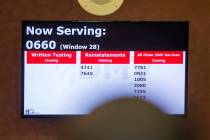Pension reform: Numbers behind DA’s decision to ‘retire’
The pending retirement of Clark County District Attorney David Roger provides an opportunity to shine some light on how pensions for public employees are calculated — and why states are facing fiscal catastrophe if they don’t enact major retirement reforms.
Mr. Roger announced Nov. 1 that he would step down from his elected post on Jan. 3 after 25 years as a county prosecutor. Mr. Roger is 50 years old and will start collecting an annual pension of about $150,000 upon leaving office.
Private-sector workers must wait until they’re at least 59½ to withdraw tax-deferred retirement savings without penalty. They must be at least 62 to collect meager Social Security distributions, and they must be 65 to get Medicare benefits. That’s 40 to 50 years of labor before retirement eligibility.
But the Nevada Public Employees’ Retirement System allows state and local government workers to begin collecting pension benefits at any age if they have worked for 30 years (for public safety workers, the threshold is 25 years). PERS also allows government workers to purchase up to five additional years of service toward their retirement eligibility, at a cost of roughly one-third their current yearly salary per year of service.
Mr. Roger purchased five years of service to reach the 30-year mark. Because his base salary is a little more than $202,000, those five years cost him around $330,000.
He had an astonishing incentive to pay that premium. Had Mr. Roger called it quits after 25 years without purchasing the five years of service, he would have had to wait until age 60 to begin collecting his pension. Moreover, based on the PERS formula that determines benefits based on years of service, Mr. Roger’s pension at age 60, for only 25 years of work, would have been about $130,000. Thirty years of service guarantees the maximum PERS benefit of 75 percent of an employee’s highest-earning years.
So Mr. Roger’s $330,000 service purchase will allow him to collect 10 years of benefits worth some $1.5 million he otherwise wouldn’t be entitled to. After taxes, he recoups his service-purchase investment in about three years.
Mr. Roger did nothing illicit or unethical. He merely exercised options available to him. This is the stark reality of the way the system works. This is the system paid for by taxpayers who have seen their savings and home values wiped out, who can only dream of retiring at age 65, let alone 50. They can only dream of buying an annuity that pays $150,000 per year for 10 years, then $20,000 per year for the rest of their lives, for just $330,000. Such a product does not exist.
At age 75, Mr. Roger will have collected about $3.75 million in pension benefits, more than he was paid during his entire prosecutorial career.
This is why, according to a study released this month by the Nevada Policy Research Institute, PERS has unfunded liabilities of more than $40 billion, not the $10 billion reported by the agency. PERS beneficiaries bear no risk. Taxpayers assume all the risk of promised pension benefits that can’t be paid.
The Nevada Legislature needs to get serious about reforming PERS. If Nevada lawmakers lack the political will to put future public-sector hires into a defined-contribution, 401(k)-style retirement system, then they should at a minimum quit paying pension benefits to anyone younger than 60. The state must stop giving productive government workers incentives to quit. It’s not just unaffordable, it’s unfair.


















